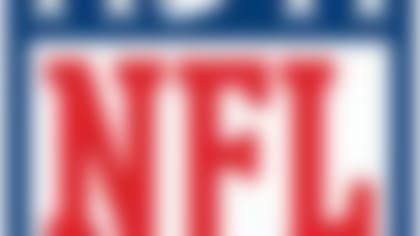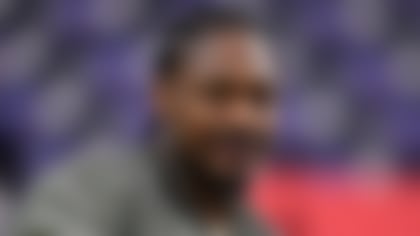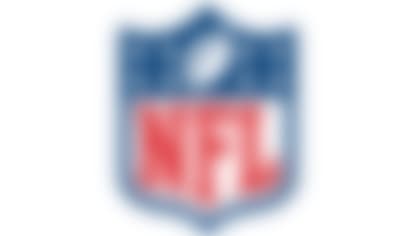NFL Media's Albert Breer touches on multiple topics in his robust Inside the NFL Notebook, including (click on each link to go directly to the topic):
» The man behind this Cardinals surge.
» A simple explanation of Marc Trestman's offensive innovation.
» One team likely to dip back into the QB pool much quicker than it had hoped.
» And much more, beginning with a look at two ballyhooed young signal-callers encountering predictable struggles ...
"Robert is so used to having teams play us in an eight-man front where they've got to stop our run, and (last year, we) had wide receivers wide open. (Last year), everybody played us in an eight-man front, sometimes almost in a nine-man front with their free safety, and when you do that, you're going to have guys wide open like we did last year -- one of the reasons why the play-action game was so good and one of the reasons why we were ranked where we were throwing the football with yards per play. This year, they're saying, 'Hey, we're going to play a little more passive. You're going to have to earn your right in that running game.' "
-- Washington Redskins coach Mike Shanahan
It won't grab headlines, nor will it fuel drive-time sports radio, but it's very much the truth: The trouble that Robert Griffin III is going through now is largely a result of what he never had to do before.
And the same, by the way, goes for San Francisco 49ers quarterback Colin Kaepernick.
You can make this one pretty simple. Last year, as the two became poster boys for the new-age NFL, they were, in essence, running their respective college offenses. A year later, the NFL has adjusted. So now it's on both guys to do the same.
"The natural instinct of both guys -- both have big arms, both can run -- is where if they can't get rid of it quickly, they pull it down and take off," one NFC personnel director said. "Part of playing quarterback is having the presence to sit there, allow routes to develop, receivers to get open, and take what's there. I don't think those guys are developed when it comes to that."
A look at the numbers illustrates where each guy stands in his development:
KAEPERNICK
GRIFFIN
And to top it off, neither quarterback's team is winning at the same rate as last season, either.
In a way, what both quarterbacks are going through was inevitable all along. Kyle Shanahan adapted the Baylor spread to Washington, the same way Greg Roman outfitted the Nevada pistol for San Francisco. Both coaches did so in an effort to make their quarterback more comfortable and maximize the athletic threat the guy taking snaps could pose. It worked, but it also made it so neither player had to evolve as much.
As Mike Shanahan explained above, defenses have learned to bottle up the option without selling out completely, forcing Griffin and Kaepernick to reach for a counterpunch. The trouble is, with both signal-callers raised in offenses where reads were simplified to allow athletes to play fast, that haymaker isn't there ... yet.
"Defenses have adjusted big time, and neither guy was in a system where he had to read the whole field -- those guys just can't do it," an NFC personnel executive said. "So when defenses take away their primary reads, it takes away what they do. They can always be the athlete -- they have great arms, great legs. They have to become more."
A second NFC personnel director said: "A lot of those (college) offenses don't even have reads. At Baylor, you read one guy and make the throw -- they had so much speed, they'd just spread you out and play fast. RGIII may be able to do it, eventually, but it's going to take repetition."
It's no mistake, then, that the transition of Andrew Luck and Russell Wilson from Year 1 to Year 2 as NFL starters has been much smoother. Both had experience in pro-style offenses as collegians, and each was asked to lean on aptitude -- not just athleticism -- while playing at that level. So when pro defenses adjusted to them, they had more answers, drawing from more developed skill sets.
In that sense, it's hard to blame either Kaepernick or Griffin for struggling at something they'd seldom before been asked to do.
And there's no question there have been mitigating factors on the periphery. Griffin's knee injury was a complicated one to return from and robbed him of hundreds -- if not thousands -- of offseason reps. Meanwhile, Kaepernick still hasn't had Michael Crabtree for a single snap this season, just got back Mario Manningham, and the 49ers have paid for striking out on 2012 first-round draft pick A.J. Jenkins.
But the fact remains, as the two get set to meet Monday night, that both have plenty of strides left to make to become complete quarterbacks -- many more than the casual observer might have recognized in 2012.
Defenses have geared up to hit the quarterbacks more often, slow down the reads on the option by slow-playing their edge guys, and are spying them with more athletic linebackers in the pass game. That also has exposed other weaknesses -- without the option opening space for easy throws over the middle, both QBs have had problems on timing throws and spinning it to the sideline -- so now is the time for Kaepernick and Griffin to try to become what they haven't needed to be before.
"They're so young, and seeing a lot of this stuff for the first time -- coverages they never thought they'd see, fronts they never thought they'd see," the NFC personnel exec said. "They're so young, coming off pretty successful years, where they kind of think they know it all and it's easy. What you don't realize if you're them is now teams have had eight months to get ready. They're both sharp guys."
The exec then added that it's "rare" an NFL quarterback learns to be a full-field-reader as a pro, if he was never one before.
"It's really not their fault," he said. "But it also won't be easy."
Which makes the next chapter, and all the elemental pieces it carries, all the more fascinating.
Cardinals flourishing under first-year GM
When Steve Keim was promoted to general manager in Arizona in January, he didn't waste any time innovating. Nor did he mess around with immediate expectations for the team: This was not going to be a rebuilding effort.
Schein: Cards are worth watching

"That was the thing I was so excited about," Keim said. "After interviewing for some other jobs that were clearly rebuilding situations, it was clear that we were retooling, not rebuilding, here. We had a core that's exciting, we had some playmakers and a fast, explosive defense, but we knew we also had to get better fast at some other spots."
That's where the new GM introduced the Cardinals' first "free-agent board."
In much the same way the team annually ranks draftable players 1 to 120, Keim, top lieutenant Jason Licht and new coach Bruce Arians compiled a wish list of 23 free agents and resolved to be uber-aggressive in their pursuit. On the first day of free agency, Rashard Mendenhall, Jerraud Powers, Drew Stanton, Jasper Brinkley, Matt Shaughnessy, Antoine Cason and Frostee Rucker visited, and each was given a take-it-or-leave offer, which allowed Arizona to move fast.
"We didn't want to get in a situation where we were going back and forth," Keim said. "Once they came in, we told them, 'We think this is a fair deal, and if you decide to take it, great. But if you leave, once you step foot outside, we're going on to the next guy."
The free-agent frenzy was only one tweak that Keim made in changing over from an old regime of which he was an integral part. Another was a willingness to take more risks. Drafting rookie defensive back Tyrann Mathieu is the obvious one. Nose tackle Alameda Ta'amu is another player who entered the pros with character questions. After being run off by the Pittsburgh Steelers as a rookie, Ta'amu found a home in the desert.
The rationale for such acquisitions? Keim felt good about the risk-averse locker room already in place.
The playoff picture

How would your team's prospects look if the season ended today? See where each team stands in the playoff picture midway through the season. **More ...**
"With a guy like (Ta'amu), we talked to people at the Steelers, people at (University of) Washington, and then you look at Darnell Dockett and Calais Campbell and say, 'Take care of this young man,' " Keim said. "Same as we did with Patrick (Peterson) and Tyrann."
There's still plenty of work left in carrying out Keim's vision. In his words, the idea is "to try to continue to minimize the amount of free-agent signings we need," and the GM knows the only way to do that is to crush it in the draft.
Of course, Arizona has a couple of key vets, too. First, Carson Palmer represents the "right now" at quarterback, but Keim said he wouldn't rule out looking for a long-term answer at the position after the season: "I think every team is a looking for a young quarterback. That's why New England took (Ryan) Mallett. And so nothing will deter us. At the same time, Carson's an age where he can still control his own destiny and make a name for himself."
Second, Larry Fitzgerald is the face of the franchise, but he comes at a high cost. For now, Keim believes the 30-year-old receiver is worth the price tag: "I've said this many times. He's not only a very, very good player, but with what he brings to the table off the field and in the community, it's hard to put a price on what he's worth."
Because so many of the players he brought in are on one-year contracts, Keim will have some tough calls to make come March. But that's a ways off and, improbably, the GM and his team have a run at a playoff spot to worry about first.
Marc Trestman's highly discussed innovation ... explained!
You hear a lot about Marc Trestman's offensive innovation. And how it helps get the most out of quarterbacks. But you rarely hear why.
The best way to explain it: It's easy to understand for the guy throwing the ball and pretty complicated for those trying to stop him.
Trestman's offense has about 30 to 40 pass principles, but six to eight ways to dress each of them up, and some 1,200 plays in total. He'll carry 150 or so plays into a game, which seems like an exceedingly high number, if you don't boil that down to a much smaller number of concepts that are cloaked in various ways.
Trestman's ability to run "flat hook" might look completely different this week than it did last week, which creates a problem for defensive preparation but really doesn't stress the offense much.
"What I've taken is that it's all about the quarterback," said Toronto Argonauts coach Scott Milanovich, who assisted Trestman in Montreal from 2008 to 2011 and coached against him last year. "That's why I assume Jay (Cutler) likes to play for him. The protections, the run game, it all revolves around quarterback play. That's paramount. In practice, defensive linemen aren't getting within three feet, there's no question who the most important guy is. And the quarterback enjoys that -- everything's revolving around him."
The other end of the bargain is that Trestman demands his quarterbacks be studious -- they need to be, in order to absorb all of the above. But because of that structure, the belief is that repetition will convert the scheme to muscle memory for the quarterback. So again, do 30 things well and make the defense account for 1,000 plays.
And the idea of making everything revolve around the quarterback doesn't stop with scheme.
"The thing that always stood out to me is how much the quarterback is protected in practice -- you don't come near him," Milanovich said. "It's discussed, it's talked about in meetings, it's not hidden. The message is there. The quarterback has to play well."
The Chicago Bears haven't set the world on fire quite the same way Trestman's two-time Grey Cup champion Alouettes did, but at 6-4, there's plenty of promise. And if he can come within shouting distance of the legacy he established in Canada, where a three-down game is played more aggressively on offense, he'll be just fine.
"Let's just say he's very highly respected up here," said Milanovich, a former Maryland quarterback who played four NFL seasons for the Tampa Bay Buccaneers. "I think a ton of people in Canada are following the Bears, and part of that is because he comes across as humble. He's well liked and well respected, and people in Canada feel like he did the league a service. You won't hear many bad things about him."
Four downs
1) NFL should make public its guidelines for officials. Last Sunday, I covered the Redskins-Eagles game, which ended with Trent Williams complaining of verbal abuse from an official. A little over 24 hours later, I was at Bank of America Stadium for the Patriots-Panthers showdown, in which the guys in the stripes took on an even more prominent role. And in reference to both cases, I've heard coaches and players complain about the impunity that the referees sometimes operate under. That's why I believe the guidelines for officials need to be better spelled out -- and made public. If a player or coach talks back to an official, it can lead to a fine. At all times, those football people are accountable to the referees. So shouldn't it be a two-way street? Here's what I'm leading to: The NFL needs more explicit guidelines for on-field conduct, ones that work for both sides. And in key spots, in order to maintain the trust of the clubs and the public, better explanations are necessary for important calls. If those things existed, Williams might have a rule to point to, and the Patriots might not be wondering if the officials spent time after the game -- before they spoke to pool reporters -- getting their story straight. Integrity-of-the-game issues always have been vital to the NFL, so this is an opportunity for the league to step up.
2) Vikings trending toward the 2014 QB market. Six weeks ago or so, just after signing Josh Freeman, Minnesota GM Rick Spielman told me, "We still believe (Christian Ponder) can be our guy," and "I know by making this kind of move, you'll be able to take the next 12 weeks to try to determine which direction we're going to in next year." On the first point, Spielman wasn't bluffing -- otherwise, Ponder certainly wouldn't have gotten this long (four starts since) a second look. And despite that, on the second point, the franchise very much appears to be in the same position it was before. At the time of the Freeman signing, Ponder had 33 career touchdown passes, 30 interceptions and a 75.8 passer rating over two-plus seasons. Since, Ponder has four touchdown passes, four picks and an 83.9 passer rating, and the team is 1-3 in his starts. The news is worse for Freeman and Matt Cassel, who haven't been able to unseat the incumbent. After the season, the Vikings have to make a decision on whether or not to pick up Ponder's option. There's just about no chance that's happening. Far more likely is Spielman deciding to find a new triggerman for 2014 and beyond. (My understanding is that Minnesota, like many other teams, is high on the signal-callers that should make up the 2014 draft class.) From there, the fortunes of that player, being the second quarterback the Spielman regime would invest in, likely would run in tandem with the GM's future with the club.
Harrison: Week 12 Power Rankings
3) Defining stretch coming for the Lions. Detroit defensive coordinator Gunther Cunningham said this to me a month ago, and it really stuck: "We beat ourselves by making dumb little mistakes. But when we're right, we're really right. And that's what we need to learn to do, just focus on the play at hand." His point applies to the entire team: When the Lions play a smart, disciplined game, they can run with anyone. The problem, of course, has been their knack for getting in their own way -- a problem that, they swear, is being eradicated inside the building. We'll find out if they're right over the next six days. In front of Detroit is a chance to create separation in the NFC North, with the sad-sack (albeit improving) Buccaneers in town Sunday, and the beat-up Packers coming in for Thanksgiving. Good, mature teams take advantage in circumstances like these. We'll see shortly if the Lions have the focus and maturity to pull it off.
4) Wes Welker's impact. There's been debate this week in New England over whether or not the Patriots were correct in letting Welker, as trusted a target as Tom Brady's had in 14 NFL seasons, bolt for Denver. Those who agree with the decision often say Welker's replaceable, with a skill set that is not unique. So I figured I'd go to Devin McCourty -- a Patriots captain who played with Welker for three years and now is preparing to cover him -- and field his thoughts on the matter. "When you say a lot of guys are like him, there are a lot of guys that get compared to him," the New England safety answered. "When people see a slot receiver, it's, 'Is he the Wes Welker type?' He's the standard. To me, what makes him unique is his toughness. While I was here, I don't think he missed a game. Always at practice. Always ready to go. Not afraid to get in there and block. He does everything for your team." Here's the thing: Receivers generally go to the slot because they lack the length and catch radius to play outside. And then, because they're smaller -- playing in the land of giants, between the numbers -- they more often than not wind up hurt a lot. Welker's the outlier, and durability has become part of his skill set. In 10 years as a pro, Welker has missed three -- three -- games because of injury. In New England, averaging over 100 catches (and hits) per season, Welker played in 93 of 96 games. Somewhere along the line, he deserves credit for that. You can see his peers already give it to him. Welker, of course, suffered a concussion against Kansas City last Sunday. But he returned to practice Thursday and is probable to play Sunday night against his former teammates.
Harrison: Week 12 Game Picks
Three checkdowns
1) Seeing the Panthers' defense in person for the first time Monday night, one thing stood out above all else: speed in the front seven. A deep rotation of linemen keeps legs fresh up front, and linebackers Luke Kuechly and Thomas Davis are lightning-quick covering the second level.
2) One GM pointed out to me in September, when studying rosters at cut-down day, how the difference in depth between Seattle and the other 31 teams jumped off the page to him. That's a good way of explaining how the Seahawks are 10-1, despite just now getting healthy.
3) Mike Vick said on Philly radio that he'd understand if Chip Kelly sticks with Nick Foles, and my feeling is that the sentiment is genuine. From what I've heard, the 33-year-old quarterback is at peace with where he is as a professional and prepared for whatever the next step is personally.
Two college players to watch Saturday
1) Minnesota DL Ra'Shede Hageman (vs. Wisconsin, 3:30 p.m. ET, ESPN): The 6-foot-6, 311-pound senior can answer plenty of questions this week against the always big, always rugged Badgers offensive front. "(Hageman) is big, athletic -- he flashes top-10 talent," an NFC personnel executive said. "He's just inconsistent with his motor and his overall play style. He plays too high sometimes. Other times, he dominates. He could end up in the top 15, because of the nature of the position, but he makes you nervous." The key is, because of Hageman's frame and athletic ability, he can play as an end in a 3-4 or a tackle in a 4-3, and that versatility never has been more valued than it is now. One AFC college scouting director said opinion in his building is split on Hageman and that he believes this probably is the case at many other places. For that reason, this game looms large. "This is a game most scouts will throw in to evaluate them, based on, if nothing else, (Wisconsin's) reputation," the college scouting director said.
2) Baylor guard Cyril Richardson (at Oklahoma State, 8 p.m. ET, ABC): For all the space-age numbers Baylor's passing game posts, would you believe that a guard and a tailback probably will be the top two prospects on the field for the Bears? Start with Richardson, a road-grading 6-5, 340-pound mauler who's a bit of a polarizing player. "He doesn't have a ton to prove; he kind of is what he is," one AFC area scout said. "He just needs to play consistent football against a highly ranked team, and I'd like to see consistency when he's asked to play in space." One AFC college scouting director called Richardson "so overrated," and there's no question that his athleticism will be under the microscope. The other player to watch might not play. Baylor tailback Lache Seastrunk, a passing-down weapon who has drawn comparisons to New England's Shane Vereen in scouting circles, is nursing a groin injury, so his status for Saturday remains up in the air. Want an idea of how good a job Art Briles is doing with the 9-0 Bears? Those two guys are the best he has, and the area scout says they are "in that second- to fourth-round range, with the potential to go up or down based on the combine and predraft stuff we do."
Extra point
As we mentioned on Ponder, the offseason ahead will be the first in which players drafted under the new rookie salary system are eligible for new deals. And in the case of the 2011 first-rounders, clubs have to make decisions on fifth-year options. So I figured we'd lay out how that'll work.
The first day that clubs can exercise those options comes just after the 2013 regular season ends, and the deadline to do so is May 3. For players taken in the top 10, the option is worth the equivalent of the 2014 transition-tag number at their position. For guys taken 11 to 32, it's the average of the third to 25th highest-paid players at their position.
Brandt: Time to turn to 2014
Gil Brandt highlights four out-of-contention teams that would be smart to consider roster moves with next season in mind. **READ**
And here's an important nuance: The option is only guaranteed for injury at the point when it's exercised. That means a team can cut a player during that fourth year and not be on the hook for the option money. The option year is only guaranteed for skill and cap if the player is still on the roster on the first day of the 2015 league year.
Let's take Cam Newton as an example. According to a source involved with the process of setting the figures, projections have the 2014 transition-tag number for quarterbacks hovering around $14 million. So before May 3, the Panthers have to make a call on whether to guarantee Newton $14 million against injury for the 2015 season. That $14 million then becomes guaranteed for skill if Newton's still on the roster in March 2015.
There are plenty of no-brainers high in the 2011 class -- guys like Von Miller, A.J. Green, Patrick Peterson, J.J. Watt (whom Houston will get at a discount, since he was taken 11th). And, on the other end of the spectrum, Blaine Gabbert. But in some cases, there's a decision point coming where the public will get a real-life read on what teams think of players.
And while we're here, let's wrap up by passing along projected franchise-tag numbers for 2014 -- fielded from the same source as above -- with the caveat that these numbers will be adjusted to whatever number the salary cap is set at:
Quarterback: $16.2 million
Defensive end: $12.6 million
Wide receiver: $11.6 million
Cornerback: $11.3 million
Offensive lineman: $11.2 million
Linebacker: $11 million
Defensive tackle: $9.2 million
Running back: $9.1 million
Safety: $8.1 million
Tight end: $6.8 million
Kicker/punter: $3.4 million
Follow Albert Breer on Twitter @AlbertBreer.



